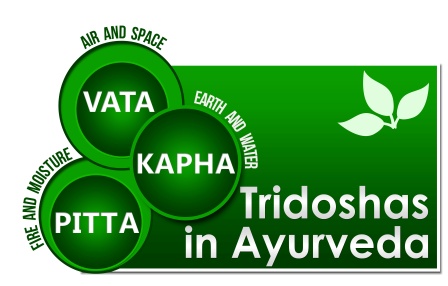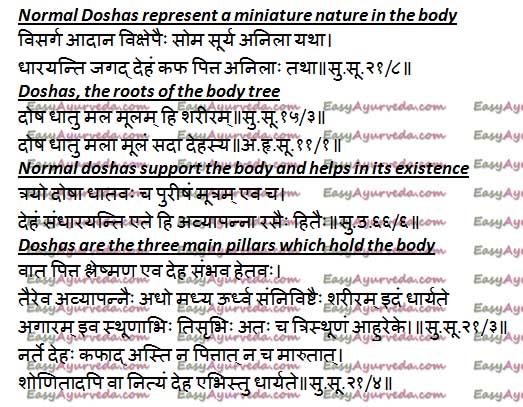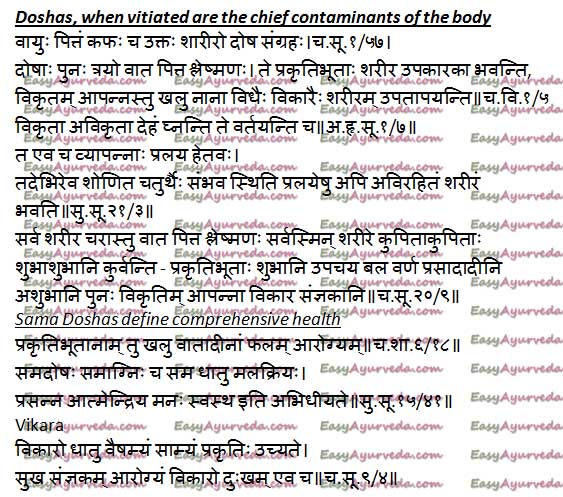Balanced Doshas And Their Contribution To Comprehensive Health
Article by Dr Raghuram Y.S. MD (Ay) & Dr Manasa, B.A.M.S
Table of Contents
Introduction
Doshas, Dhatus (tissues) and Malas (excreta) form three sets of important body components which govern the entire structural and functional balance of the body. While tissues make up the structural components, Doshas form functional components of the body. The excreta help in maintenance of health by getting eliminated out of the system in proper time and in proper quantities.
In a state of normalcy the doshas, tissues and waste products all are said to be constructive components and contribute towards comprehensive health of an individual. Thus all three are called as dhatus in a state of normalcy.
When in equilibrium, all three work in their own strata within the brackets of their limitations without meddling with each other. But when contaminated, the doshas would contaminate tissues and waste products to cause diseases.

Similarly, the waste products on not getting excreted and getting stagnated in the body will contaminate the body and cause diseases. The dhatus are always on the receiving end and will get damaged if they are not strong enough to resist the invasion of a vitiated dosha(s).
For a comprehensive health, the balance of these elements is the key.

Sama Dosha and Health
Sama (Prakritastha) Dosha, their contribution towards comprehensive health
Doshas, in their state of normalcy (sama doshas) represent a miniature nature in the body
According to Ayurveda, everything in our body represents the things existing in the universe. Therefore there is a small nature in our body.
The wind element is represented in the form of vata, the fire element or Sun is represented in the form of pitta and water element or Moon is represented in the body in the form of kapha. Though they are different elements with different properties, they live in the same body and render their functions without meddling into each other’s activities as long as they are in a state of balance. But when they are aggravated due to the influence of many etiological factors or nidanas in the form of unwholesome foods, erratic lifestyle etc, they tend to produce diseases just like the wind body produces tornados, fire body cause volcanoes and water body cause tsunamis when they are disturbed.
Just like the Moon, Sun and Air protect the entire universe through their
visarga (nourishing, coolant),
adana (depleting) and
vikshepa (balancing) acts respectively, the Kapha, Pitta and Vata too protect the body through their visarga (kapha), adana (pitta) and vikshepa (vata) functions as long as they are in state of normalcy.
Dosha as root of body
Doshas, the roots of the body tree
As already said, along with tissues and excreta, the doshas form the basic components of the body, they all form the roots of the tree called human body (shareera).
Normal doshas support the body and helps in its existence
The three doshas along with tissues and excreta are considered as roots of the body as they are responsible for to support the body when they are in a state of balance.
Doshas are the three main pillars which hold the body
Vata, Pitta and Kapha form the main pillars which support and are responsible for the existence of a house called body. When the doshas are balanced, they support the body and enable its healthy existence, just like the pillars(sthunas) support a house. Therefore, the three doshas are also called as tri-sthunas or three pillars.
Acharya Sushruta also opines the same and tells that vata, pitta, kapha and rakta, adorn the human body and support its existence, as long as they are in a state of balance.

Dosha as body contaminants
Doshas, when vitiated are the chief contaminants of the body
Vata, pitta and kapha are called as doshas. Dosha means that which has a capacity to contaminate the other elements of the body. Doshas, when get vitiated, can contaminate the tissues, excreta and other elements of the body like srotases (channels of the body) etc and cause wide array of systemic diseases.
Protective and Destructive role
Thus, the doshas adorn dual roles in the body in different circumstances. They support the body when they are in a state of equilibrium and hence called as dhatus when they do so. The same doshas when vitiated will vitiate other body components and cause diseases. Therefore they are called as doshas when they tend to vitiate. When the doshas which are vitiated stay back in the body without being expelled, they further contaminate the body components by causing multiple blocks and hence they are also called malas when they do so. Thus doshas in equilibrium contribute towards positive health.
Acharya Charaka tells that the normal doshas are beneficial for the body but the vitiated doshas trouble the body seriously by producing many diseases.
Acharya Vagbhata tells that when the doshas are in vitiated form, they destroy the body while they protect the body when they are in a state of equilibrium.
Acharya Sushruta too doesn’t have different opinion. He too states that the same doshas, which are protective in a state of balance will destroy the whole body when they get vitiated. The vitiated blood too behaves like vitiated doshas and would destroy the body when gets vitiated.
Charaka further extends his explanation over the dual contrasting roles of normal and abnormal doshas in the body and tells that the vata, pitta and kapha circulate all through the body and cause beneficial effects when in normalcy and cause harmful effects when in vitiated form.
The shubha karyas include bestowing the body with upachaya (nourishment), bala (strength), varna prasada (color to the body) etc. The ashubha karyas are in the form of various diseases.
Sama Doshas define comprehensive health
Acharya Charaka tells that the effect of balanced doshas is arogya i.e. comprehensive health.
Acharya Sushruta mentions equilibrium of doshas is responsible for swasthya i.e. total health. He defines swastha ( healthy person) as the one who has a state of equilibrium of doshas, equilibrium of digestive fire, equilibrium of tissues, timely elimination of waste substances of the body, pleasantness of the soul, pleasantness of sense organs and pleasantness of mind.
Thus, the diseases are said to be resultant of dhatu vaishamya (vitiation of doshas, dhatus and malas) and health is a resultant of dhatu samya (equilibrium of dosha, tissues and excreta). Diseases is responsible for grief while healthy condition is responsible for happiness.
Thus, dosha samya is responsible not only for comprehensive health, but also for happiness.
In short –
With the help of the above mentioned evidences and references we can tell that the doshas in equilibrium is the most essential factor for smooth conduit of body functions and also for maintenance of comprehensive health and immunity of an individual.
Dosha gati, movement or status of doshas which is one of the causes for dosha dushti comprises of a triad comprising of vriddhi (increase), sthana (normalcy) and kshaya (decrease) of doshas. Among these gatis, only sthana of dosha is normal gati, the other two are pathological states.
Related Reading – Types of Dosha Gati
Sama Dosha importance
Importance of having the knowledge of sama doshas
For a physician, it is important to have a comprehensive knowledge of sama doshas because it is only on the basis of this knowledge that the pathological states of doshas (dosha dushti) and the mode of manifestation of disease, pathogenesis and diseased state could be understood. The knowledge of normal things always gives the knowledge of abnormal things.
How do we know that the doshas are in a state of balance
Sama doshas can be understood on the basis of functions of doshas in a state of normalcy as explained in Ayurvedic texts.
Click to Consult Dr Raghuram Y.S. MD (Ayu) – Email / Skype










